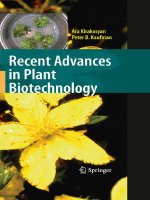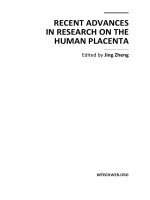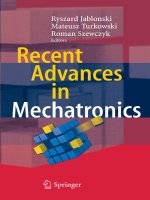Recent Advances in Ultrahigh Performance Concrete
Bạn đang xem bản rút gọn của tài liệu. Xem và tải ngay bản đầy đủ của tài liệu tại đây (975.04 KB, 10 trang )
Print ISSN : 2288-3320
Online ISSN : 2288-369X
J Rec Const Resources 1(3)163-172(2013)
/>
Recent Advances in Ultra-high Performance Concrete
1
Yail J. Kim *
(Received October 4, 2013 / Revised December 5, 2013 / Accepted December 8, 2013)
This paper presents a comprehensive review of recent advances in ultra-high performance concrete (UHPC). Fundamental
characteristics of UHPC are elaborated with focus on its material constituents, mixing, and formulation procedures. Use of
state-of-the-art materials such as carbon nanotubes or nano-silica is discussed as well, whose inclusion may enhance the performance
of UHPC. The review evaluates supplementary treatment methods (e.g., pressuring curing) and identifies applicable standard test
methods for determining the properties and behavior of UHPC. Site implementation is provided to link laboratory research with
full-scale application. Research needs are suggested to further develop UHPC technologies from technical and socio-economical
perspectives.
Keywords : Review, State-of-the-art, Test methods, Ultra-high performance concrete (UHPC)
strength, UHPC requires a low water-to-cementitious binder
1. INTRODUCTION
ratio (e.g., less than 0.25). Porosity characteristics of UHPC
reduce the flow of water, thereby improving durability in
Demand for sustainable structures is increasing nowadays.
aggressive environment (FHWA 2011). Use of a superplasticizer
Ultra-high performance concrete (UHPC) is a promising
addresses the workability issue of UHPC. Potential application
material to address such a requirement from state or federal
of UHPC is broad from bridge structures to nuclear power
agencies. UHPC is a specially designed concrete that meets
plants. UHPC has increasingly been used around the world
the needs for specific service conditions, particularly infrastr-
(Blais and Couture 1999; Rouse et al. 2011; Planete 2012).
ucture and multi-story buildings. UHPC is generally defined
Advantages of UHPC include the long-span of flexural
as a very high strength cementitious composite material,
members with light weight, minimal use of steel reinforcement,
containing optimally graded aggregate and fiber reinforce-
increase in tensile strength and toughness, resistance to
ment. Typical composition of UHPC includes Portland cement,
harsh service conditions, accelerated construction, and
fine aggregate, water, supplementary cementitious materials,
reduced long-term maintenance costs (Graybeal 2009; Al-Azzawi
a superplasticizer, and discrete reinforcing fibers. Unlike
et al. 2011). The relatively high material costs of UHPC can be
conventional concrete, coarse aggregate is not used. UHPC
offset with reduced long-term maintenance expenses (Semioli
has demonstrated superior mechanical properties compared
2001).
to conventional concrete (FHWA 2011). For example, compre-
Extensive effort has been made on formulating UHPC (to be
ssive strength of UHPC ranges between 170 MPa and 230 MPa
discussed), whereas its development is still in infancy. Of
in most cases (Ahlborn et al. 2008). To achieve such a high
interest are the material costs of UHPC and the application of
* Corresponding author E-mail:
1
Associate Professor, Department of Civil Engineering, University of Colorado Denver, Denver, CO 80217, USA
Copyright ⓒ 2013 by Korean Recycled Construction Resources Institute
This is an Open-Access article distributed under the terms of the Creative Commons Attribution Non-Commercial License ( />which permits unrestricted non-commercial use, distribution, and reproduction in any medium, provided the original work is properly cited
Yail J. Kim
local materials. Limited research has been conducted to
address these issues from a practical point of view. Technical
challenges associated with the site application of UHPC are
as follows:
2. CHARACTERISTICS AND IMPLEMENTATION
OF UHPC TECHNOLOGY
2.1 Design of UHPC
- Readiness of formulation and implementation: special mix
design and procedures are necessary to adequately
formulate UHPC; however, there are no code provisions or
standards in the United States which makes enduser sector
hard to enjoy the benefit of UHPC.
- Excellent performance with reasonable costs: although the
material costs of UHPC have consistently been decreasing
since it was first introduced to the construction community,
UHPC is still an expensive material to use. Positive approaches to reduce costs are necessary. Use of regionally
available materials can decrease transportation expenses
and the dependency of commercial products.
To accomplish the success of various construction projects
with the benefit of UHPC, these challenges must be thoroughly
addressed. It is important to note that the technical and
economical issues identified are critical for those who are
interested in sustainable structures. This paper reviews the
state-of-the-art relevant to the practical application of UHPC
and further elaborates critical research needs for improving
the design and implementation of UHPC. Emphasis is placed
on material characteristics, design and implementation, supplementary treatment, applicable test methods, and site application.
Typical concrete shows a compressive strength (f’c) from
20 MPa to 35 MPa. The need for high strength and improved
performance is emerging to build sustainable structures. The
advent of reactive powder concrete with f’c ranging from 200
MPa to 800 MPa overcomes the limitations of conventional
normal strength concrete (Reactive 2002). UHPC addresses
the following engineering characteristics: strength, elastic
modulus, abrasion, durability, permeability, chemical resistance,
impact, placement difficulty, and long-term maintenance
costs. The strength range of UHPC mentioned above exceeds
the strength of high strength concrete by two to six times
(Lubbers 2003; Schneider et al. 2004). Table 1 compares
typical engineering properties of UHPC with those of normal
and high strength concrete. Although the theory of traditional
reinforced concrete may be used for the application of UHPC,
care should be exercised because some empirical factors
have been developed based on the behavior of conventional
concrete. No codified provisions are available for UHPC in the
United States. Therefore, experienced technical personnel can
only assure the adequacy of UHPC design and construction.
Optimal use of constituent materials is important for the
implementation of UHPC. According to a comparative study
(Blais and Couture 1999), steel fibers in UHPC (a length of 25
mm and a diameter of 0.2mm) are equivalent to reinforcing
bars of 8 mm in diameter and 1000mm in length for normal
Table 1. Typical comparison of engineering properties of UHPC with normal and high strength concrete (compiled based on Ahlborn
et al. 2008)
164
Property
Normal concrete
High strength concrete
UHPC
Compressive strength
3,000-6,000 psi
6,000-14,000 psi
25,000-33,000 psi
Tensile strength
400-500 psi
-
1,000-3,500 psi
Elastic modulus
2,000-6,000 ksi
4,500-8,000 ksi
8,000-9,000 ksi
Poisson’s ratio
0.11-0.21
-
0.19-0.24
Porosity
20-25%
10-15%
2-6%
Chloride penetration
>2000
500-2000
<100
Water-cement ratio
0.40-0.70
0.24-0.35
0.14-0.27
Vol. 1, No. 3 (2013)
Recent Advances in Ultra-high Performance Concrete
concrete. Removal of coarse aggregate will reduce the
UHPC is enhanced. A compressive strength of 97 MPa may
interfacial transition zone between the cementitous binder and
be a good indicator of adequate hydration (FHWA 2011). Qian
aggregates and thus improve tensile strength (Mindess et al.
and Li (2001) reported that the tensile strength and corres-
2003; Mehta and Monteiro 2006). Supplementary cementitious
ponding strain of concrete increased with an increasing
materials such as silica fume fill micro-voids to produce a
metakaolin content, whereas the elastic modulus of the concrete
dense mixture with low permeability. Limited effort has been
was independent of metakaolin. UHPC mixed with silica fume
done on using nano-scale materials for the design and
showed a higher compressive strength than that with high
practice of UHPC (Kowald 2004).
reactivity metakaolin (Al-Azzawi et al. 2011). Due to the dense
mixture of the constituents, UHPC demonstrates low permeability
2.2 Material composition
Most composition of UHPC is dry particles, while liquidoriented constituents are limited. UHPC is typically comprised
of Portland cement, supplementary cementitious materials,
quartz powder, water, fine aggregate, a superplasticizer, and
fibers. Use of fine aggregate and quartz powder increases
density, whereas decreases porosity. The particle size of fine
aggregate affects the homogeneity of UHPC (Richard and
Cheyrezy 1995). Quartz is easily obtainable and has a very
strong compressive strength (1,100 MPa) with an inexpensive
price (about $150 per ton). Steel or organic fibers are
commonly used for UHPC, including a fiber ratio from 1.0% to
2.0% (Al-Azzawi et al. 2011). Because of the embedded fibers,
the crack width of UHPC is much less than that of conventional
concrete (FHWA 2011). The effect of fiber content influences
the post-peak behavior of UHPC in tension, while such an
effect may not be critical for compressive strength (Ali 2007;
Redaelli and Muttoni 2007; Al-Azzawi et al. 2011). Attention
needs to be paid when the tensile strength of UHPC is
measured because the internal fibers can have an impact on
the cracking response of the concrete such as strainhardening (FHWA 2011). Silica fume and high reactivity
metakaolin are widely used materials (Ali 2007). Silica fume
includes amorphous silica dioxide and reacts with calcium
hydroxide (Al-Azzawi et al. 2011). Metakaolin is white clay and
is obtained by treating kaolin. Metakaolin (typically 0.005 mm
in diameter) is an abundant material and its primary
composition includes SiO2 and Al2O3 (Sabir et al. 2001). These
supplementary cementitious materials chemically react with
the hydration process of cement so that the performance of
(Ahlborn et al. 2008). The performance of UHPC is enhanced
accordingly, such as freeze-thaw resistance and reduced
corrosion of reinforcing steel. Permeability of concrete controls
chloride penetration, thereby increasing the corrosion potential
of embedded reinforcing steel bars (Lubbers 2003; Ahlborn
et al. 2008). UHPC effectively addresses this concern according
to experimental investigations (e.g., oxygen permeability less
than 3.9 × 10-12mm2, AFGC 2002). The water-cementitious
binder ratio of UHPC (typically ≤ 0.25) is lower than that of
normal concrete. A superplasticizer improves workability that
may be problematic because of such a low water-binder ratio.
Collepardi et al. (1996) studied the efficacy of a superplasticizer and silica fume on the compressive strength of UHPC.
Test results include that acrylic polymer demonstrated better
performance than sulfonated melamine and sulfonated naphthalene.
Strength gain at early age of UHPC is of interest. The reason
is that UHPC exhibits a gradual decrease in strength with time
owing to a reduction in water content and the chemical reaction
associated with supplementary cementitious materials commencing
in a few days of concrete-casting (Al-Azzawi et al. 2011).
Although some research has been conducted as to the
behavior of UHPC with carbon nanotubes it is still inconclusive
(Wille and Loh 2010). For example, an increase in compressive
strength over 12% was observed when multi-walled carbon
nano tubes (MWNT) were included in a UHPC mix (Li et al.
2005; Kowald et al. 2008); however, some experimental
programs reported that the inclusion of MWNT caused the
reduction of strength (Musso et al. 2009). Alternative nanoscale materials may be used for the mix of UHPC, such as
nano silica.
한국건설순환자원학회 논문집 2013년 12월
165
Yail J. Kim
2.3 Mixing, curing, and formulation procedures
UHPC is improved (Lubbers 2003). To maintain the watercementitious binder ratio of an UHPC mix as designed, the
Mixing is an important component to attain the best
surface of the concrete should be covered immediately after
performance of UHPC. Fig. 1 shows typical procedures to mix
a casting event. It is important to note that water content
UHPC. The mix design and procedures of UHPC are different
affects the behavior of UHPC because the concrete requires
from those of normal concrete. Selected mix designs for UHPC
a hydration process. Inadequate hydration action causes
are summarized in Table 2. Improving the density of UHPC is
premature shrinkage cracks and degraded engineering
a critical factor to achieve high strength and durable perform-
properties accordingly (FHWA 2011). The low water-cementitious
ance when subjected to aggressive service conditions. The
binder ratio of UHPC may cause disintegration of the constituents
particle size of aggregate needs to be carefully determined
during mixing. Inclusion of nano particles may improve bond
because it governs the homogeneity of UHPC. Improved
between the steel fibers and cementitious binder of UHPC
homogeneity increases the reliability of UHPC (Lubbers 2003).
(Wille and Loh 2010). Special procedures are required to
UHPC uses significantly smaller aggregates in comparison to
ensure consistent quality on site. Care should be exercised
other types of concrete (Richard and Cheyrezy 1995; Bonneau
when casting UHPC because of its extended setting time and
et al. 1997): cement particles (0.01mm to 0.08mm), quartz
potential segregation (i.e., discrete fibers may not function well
powder (0.01mm to 0.015mm), and silica fume (0.1 × 10 mm to
6
if excessive vibration is done). The mixing procedures of
0. 2 × 10 mm). Typical size of steel fibers in UHPC is 0.2 mm
6
UHPC can thus influence material properties depending upon
in diameter and less than 25mm long (Blais and Couture 1999).
the sequence and mixing time (Lubbers 2003).
Embedded fibers tended to align in the direction of concrete
flow when UHPC is cast and thus the modification of concrete
2.4 Supplementary treatment
rheology requires technical attention (FHWA 2011). The
embedded fibers can replace temperature and shrinkage steel
A variety of treatment methods are used to enhance the
reinforcement in concrete. In some cases, shear stirrups are
performance of UHPC. Heat treatment during the curing of
not included in a reinforced concrete beam (Reactive 2002).
UHPC can accelerate the action of silica fume, resulting in an
Supplementary cementitious materials can fill the pore space
increase in strength (Schachinger et al. 2008). Previous
between constituents so that the durability performance of
research reports optional heat treatment has improved the
Dry
components
mixed
Liquid
components
added
Dry and liquid
components mixed
Fibers
added
Supplementary liquid
components added
UHPC
Fig. 1. Typical sequence of mixing UHPC
Table 2. Composition of materials for UHPC (percent by weight)
Reference
Cement
W/C ratio
Fiber
SCM
Quartz powder
Super-plasticizer
Sand
Compressive
strength
B&C
28%
0.28
7%(S)
9%(SF)
8%
1%
40%
200 MPa
Bonneau
28%
0.27
6%(S)
9%(SF)
9%
2%
41%
190 MPa
HDR
37%
0.14
6%(S)
9%(SF)
0%
2%
41%
160 MPa
R&C
32%
0.19
6%(S)
7%(SF)
13%
1%
35%
200 MPa
W&L
32%
0.22
0.007%(CNT)
8%(SF)
8%
0.2%
44%
194 MPa
Ahlborn
26%
0.20
6%(S)
Pre
Pre
1%
Pre
194 MPa
166
Vol. 1, No. 3 (2013)
Recent Advances in Ultra-high Performance Concrete
(a)
(b)
(c)
Fig. 2. Bridges with UHPC (photos are used with permission from ASPIRE): (a) Cat Point Creek Bridge in Warsaw, Virginia; (b) Jakway
Park Bridge, Aurora, Iowa; (c) State Route 23 over Otego Creek, Oneonta, New York
(a)
(b)
(c)
Fig. 3. UHPC joint (photos are used with permission from ASPIRE): (a) erection of a bulb-tee girder; (b) installed steel cage for a UHPC
joint; (c) casting of UHPC
한국건설순환자원학회 논문집 2013년 12월
167
Yail J. Kim
strength of UHPC as high as 70% (Bonneau et al. 1997). Typical
electrical indication of concrete’s ability to resist chloride ion
conditions for such heat treatment include a temperature
penetration) may be used to assess the degree of chloride ion
range between 50℃ and 90℃ in moisture for 48 hours
penetration (ASTM 2012b). AASHTO TP-60-00 (Standard
(Bonneau et al. 1997; Reda et al. 1998). Heat treatment can
method of test for coefficient of thermal expansion of hydraulic
reduce shrinkage and creep by improving the reaction of silica
cement concrete) may be utilized to measure the coefficient
fume and a hydration process (Bouygues et al. 2002). It
of thermal expansion (AASHTO 2007). If the long-term behavior
should, however, be noted that overheating may take place
of UHPC is concerned, ASTM C512 (Standard test method for
when UHPC is mixed because of its longer mixing time
creep of concrete in compression) will be useful for a creep
compared to conventional concrete (FHWA 2011). Improvement
test (ASTM 2010b). The freeze-thaw durability of the concrete
in mix-procedures is necessary to preclude potential
may be examined by ASTM C666 (Standard test method for
heat-induced residual damage in UHPC. Ahlborn et al. (2008)
resistance of concrete to rapid freezing and thawing) (ASTM
examined the effect of steam treatment on the strength
2008b).
variation of UHPC, including durability performance. Test
results showed that UHPC effectively resisted freeze-thaw and
2.6 Site implementation
chloride ion penetration. Additional pressure may be applied
Potential application of UHPC is broad such as bridge
to reduce the porosity of UHPC that is caused by the
structures, tunnels, nuclear power plants, and liquid storage
LeChatelier contraction (Aitcin 1998). The pressure applied
facilities. UHPC is an ideal material for structures exposed to
during curing tends to decrease porosity by reducing
abrasion environment. Several site projects using UHPC have
entrapped air and excessive water and hence the
been completed, including Sherbrooke Footbridge in Canada,
compressive strength of the concrete increases (Blais and
Footbridge of Peace in Korea, and Jakway Park Bridge in the
Couture 1999).
United States (Blais and Couture 1999; Resplendino and
2.5 Test methods
Petitjean 2003; Kollmorgen 2004; Schmidt and Fehling 2005;
Rouse et al. 2011; Planete 2012). Figure 2 illustrates some
Standard test methods are currently unavailable for
selected examples of UHPC-based bridges in the United
measuring the properties of UHPC. The following test methods
States: the depth and length of the girders shown in Fig. 2(a)
developed for concrete materials may be used for UHPC until
and (b) vary from 838 mm to 1143 mm and 25.9 m to 26.5 m,
specific standards are published. ASTM C39 (Standard test
respectively. Another application is given in Fig. 3 with the
method for compressive strength of cylindrical concrete
details of installing UHPC joints connecting bulb-tee girders.
specimens) and C109 (Standard test method for compressive
A comprehensive study of UHPC was recently published by
strength of hydraulic cement mortars) can be used for the
the Federal Highway Administration (Graybeal 2006). Steel
compressive test of UHPC (ASTM 2011, 2012a). ASTM C469
fibers are widely used for site application, while polypropylene
(Standard test method for static modulus of elasticity and
fibers can improve permeability, and abrasion and impact
Poisson’s ratio of concrete in compression) may be used to
resistance (Toutanji 1999; Lubbers 2003). Considering the
measure the elastic modulus of UHPC (ASTM 2010a). ASTM
reduced use of reinforcing steel, more versatile architectural
C1018 (Standard test method for flexural toughness and
and structural design may be available. The increased
first-crack strength of fiber-reinforced concrete) will be a
toughness of UHPC makes this material ideal for concrete
reference for examining the flexural strength of UHPC (ASTM
structures in seismic regions (Reactive 2002). Although the
1997). ASTM C1437 (Standard test method for flow of hydraulic
initial expenses associated with UHPC are more than those of
cement mortar) can measure the rheological characteristics of
normal concrete, material costs are consistently decreasing
UHPC (ASTM 2007). ASTM C1202 (Standard test method for
with more site projects.
168
Vol. 1, No. 3 (2013)
Recent Advances in Ultra-high Performance Concrete
3. SUMMARY AND CONCLUDING REMARKS
- Quality control in UHPC production is an interesting issue
to warrant satisfactory in-situ performance, provided the
This paper has dealt with an overview of UHPC for civil
history of UHPC is much shorter than that of normal
infrastructure. The state-of-the-art construction material
concrete. Several field demonstration projects have exhibited
consists of Portland cement, mineral supplementary admixtures
the successful implementation of UHPC. Longterm monitoring
such as silica fume or metakaolin, quartz powder, water, fine
of field data are, however, unavailable at this time.
aggregate, a superplasticizer, and steel or organic fibers. The
Structural health monitoring technologies are recommended
following characteristics of concrete are improved when UHPC
to be along with UHPC construction.
is used: homogeneity, density, ductility, and micro-structural
integrity. Strength and durable performance of UHPC are
primary considerations for building sustainable concrete
4. CURRENT CHALLENGES AND RESEARCH
NEEDS
structures. Integration effort with nano-scale materials has
recently been made to further enhance the property of UHPC.
The following is concluded:
Despite the recent advancements in UHPC research,
significant effort is still necessary to improve its engineering
properties and applicability on site. The following challenges
- UHPC has a number of advantages compared to conventional
concrete in terms of strength, durability, resistance to
and research needs are proposed to be addressed technically
and socioeconomically:
impact and abrasion, and permeability. Adequate mixing of
UHPC results in enhanced density and homogeneity that are
- Design approaches dedicated to UHPC should be developed
beneficial to accomplishing reliable performance on site.
so that those based on conventional concrete can be
- A very low water-to-binder ratio is used to increase the
replaced to better facilitate the application of UHPC with
compressive strength of UHPC, typically less than 0.25. The
corresponding technical benefits; for example, design
role of a superplasticizer is important to provide acceptable
provisions on the minimum member depth of normal concrete
workability to such a densely mixed concrete. Optimal use
may result in the over-design of UHPC members. Codified
of constituents is a crucial factor. Inclusion of fibers controls
design provisions need to follow for practicing engineers.
the cracking behavior of UHPC, in particular its post-peak
In so doing, uniform structural performance is anticipated
response. Care should, therefore, be taken when selecting
with a consistent level of reliability.
fiber types.
- Chemical reaction between the supplementary cementitious
- Given UHPC does not use coarse aggregate, the size of
materials and aggregate requires further research from a
embedded constituents (e.g., fine aggregate, cementitious
long-term durability perspective, including freeze-thaw
materials, and fibers) dominates the behavior of the concrete.
and corrosion issues for UHPC-based concrete structures
Emerging materials such as nano-silica may be added
in
when designing UHPC, while the efficacy of nanoscale
technologies may be incorporated with UHPC to improve the
materials is not conclusive yet.
sustainability of constructed structural members.
aggressive
environmental
regions.
Self-healing
- Various treatment methods can increase the effectiveness
- Early age behavior needs more research because the initial
of UHPC, including heat treatment and pressuring during a
hydration process of UHPC causes noticeable heat-dispersion
curing period. Currently available test methods may be used
that can reduce the moisture content of the concrete.
for determining the properties of UHPC, whereas standard
Premature shrinkage cracks may then develop. Disintegr-
test methods to meet the specific needs of UHPC shall be
ation of fibers from the cementitious binder can be another
released.
problem associated with the moisture issue. Microme-
한국건설순환자원학회 논문집 2013년 12월
169
Yail J. Kim
chanical models will be useful for better elucidating the
behavior of UHPC such as the interfacial transition zone
between the binder and mineral admixtures.
- The cost of UHPC is one of the most notable challenges
University of Technology, Bagdad, Iraq.
ASTM. 1997. Standard test method for flexural toughness and
first-crakcing strength of fiber-reinforced concrete using
beam with third-point loading (ASTM C1018-97), American
interfering broad use of such a promising technology in
Society for Testing and Materials, Conshohocken, PA.
practice. Inexpensive alternative materials should be
ASTM. 2007. Standard test method for flow of hydraulic cement
incorporated into the design of UHPC to reduce material
mortar (ASTM C1437-07), American Society for Testing and
expenses. Of interest are locally available constituents,
Materials, Conshohocken, PA.
which will influence construction costs.
- Development of non-conventional environmentally friendly
ASTM. 2008b. Standard test method for resistance of concrete
to rapid freezing and thawing (ASTM C666-08), American
cementitious binders is urgent to address socio-economical
Society for Testing and Materials, Conshohocken, PA.
issues related to energy consumption and greenhouse gas
ASTM. 2010a. Standard test method for static modulus of
emission. Lifecycle cost analysis will be an important
elasticity and Poissn’s ratio of concrete in compression
component to assess the feasibility of such a new approach.
(ASTM C469-10), American Society for Testing and Materials,
Conshohocken, PA.
ACKNOWLEDGMENTS
ASTM. 2010b. Standard test method for creep of concrete in
compression (ASTM C512-10), American Society for Testing
The writer acknowledges Professor Kyoung-kyu Choi at
Soongsil University for inviting this article. ASPIRE has
provided permission to the pictures used here.
and Materials, Conshohocken, PA.
ASTM. 2011. Standard test method for compressive strength
of hydraulic cement mortars (ASTM C109-11), American
Society for Testing and Materials, Conshohocken, PA.
References
AASHTO. 2007. Standard method of test for coefficient of
ASTM. 2012a. Standard test method for compressive strength
of cylindrical concrete specimens (ASTM C39-12), American
Society for Testing and Materials, Conshohocken, PA.
thermal expansion of hydraulic cement concrete (AASHTO
ASTM. 2012b. Standard test method for electrical indication of
TP-60-00), American Association of State Highway and
concrete’s ability to resist chloride ion penetration (ASTM
Transportation Officials, Washington, D.C.
C1202-12), American Society for Testing and Materials,
AFGC. 2002. Ultra high performance fibre reinforced concretes,
Interim Recommendations, Association Francaise de Genie
Civil, France.
Ahlborn, T.M., Peuse, E.J., and Misson, D.L. 2008. Ultra-high
performance concrete for Michigan bridges, Center for
Conshohocken, PA.
Bonneau, O., Lachemi, M., Dallaire, E., Dugat, J., and Aitcin,
P. 1997. Mechanical properties and durability of two
industrial reactive powder concretes, ACI Materials Journal,
94(4), 286-290.
Structural Durability, Michigan Technological University,
Bouygues, Lafarge, and Rhodia. 2002. Ductal. www.ductal.com
Houghton, MI.
Blais, P. and Couture, M. 1999. Precast, prestressed pedestrian
Aitcin, P. 1998. High-performance concrete, Routledge, NY.
bridge- world’s first reactive powder concrete structure,
Al-Azzawi, A., Ali, A.S., and Risan, H.K. 2011. Behavior of ultra
PCI Journal, 44(5), 60-71.
high performance concrete structures, ARPN Journal of
Engineering and Applied Sciences, 6(5), 95-109.
Collepardi, S., Coppola, L., Troli, R., and Collepardi, M. 1996.
Mechanical properties of modified reactive powder
Ali, A.S. 2007. Mechanical properties and durability of polymer
concrete, International Conference on Superplasticizers
modified RPC exposed to oil products, PhD Thesis,
and the Chemical Admixtures in Concrete, ACI-SP173, 1-21.
170
Vol. 1, No. 3 (2013)
Recent Advances in Ultra-high Performance Concrete
FHWA. 2011. Tech note: ultra-high performance concrete,
Qian, X. and Li, Z. 2001. The relationships between stress and
FHWA-HRT-11-038, Federal Highway Administration, Was-
strain for high-performance concrete with metakaolin,
hington, D.C.
Cement and Concrete Research, 31, 1607-1611.
HDR. 2002.Tensile properties of VHSC, HDR, Inc (adopted from
Reactive powder concrete. 2002. Emerging Construction
Technologies, www.new-technologies.org/ECT/Civil/reactive.htm
Lubbers 2003)
Graybeal, B.A. 2006. Material property characterization of
Reda, M., Shrive, N., and Gillot, J. 1998. Microstructural
ultra-high performance concrete, FHWA-HRT-06-103,
investigation of innovative UHPC, Cement and Concrete
Federal High way Administration, Washington, D.C.
Research, 29(3), 323-329.
Graybeal, B.A. 2009. UHPC making strides, Public Roads,
Redaelli, D. and Muttoni, A. 2007. Tensile behavior of
Federal Highway Administration, Washington, D.C., 72(4),
reinforced ultra-high performance fiber reinforced concrete
17-21.
elements, Concrete Structures-Stimulators of Development,
Kollmorgen, G.A. 2004. Impact of age and size on the mecha-
267-274.
nical behavior of ultra-high performance concrete, MS
Resplendino, J. and Petitjean, J. 2003. Ultra-high performance
Thesis, Michigan Technological University, Houghton, MI.
concrete: first recommendations and examples of application,
Kowald, T. 2004. Influence of surface modified carbon
3rd International Symposium on High Performance Concrete,
nanotubes on ultra-high performance concrete, Proceedings
of the International Symposium on Ultra High Performance
PCI, Orlando, FL.
Richard, P. and Cheyrezy, M. 1995. Composition of reactive
powder concretes, Cement and Concrete Research, 25(7),
Concrete, Kassel, Germany, 195-202.
Kowald, T.R., Trettin, N., Dorbaum, T., Stadler, T., and Jian,
1501-1511.
X. 2008. Influence of carbon nanotubes on the microme-
Rouse, J., Wipf, T.J., Phares, B.M., Fanous, F., and Berg, O.
chanical properties of a model system for ultra-high
2011. Design, construction, and field testing of an ultra-high
nd
performance concrete, Proceedings of 2
International
Symposium on Ultra High Performance Concrete, 129-134.
performance concrete Pi-girder bridge, Bridge Engineering
Center, Iowa State University, Ames, IA.
Li, G.Y., Wang, P.M., and Zhao, X. 2005. Mechanical behavior
Sabir, B.B., Wild, S., and Bai, J. 2001. Metakaolin and calcined
and microstructure of cement composites incorporating
clays as pozzolans for concrete: a review, Cement and
surface-treated multi-walled carbon nanotubes, Varbon,
Concrete Composites, 23, 441-454.
43(6), 1239-1245.
Schachinger, I., Hilbig, H., and Stegel, T. 2008. Effect of curing
Lubbers, A.R. 2003. Bond performance between ultra-high
temperature at an early age on long-term strength
performance concrete and prestressing strands, MS Thesis,
development of UHPC, 2 International Symposium on Ultra
Ohio University.
High Performance Concrete, Kasel, 205-212.
Mehta, P.K. and Monteiro, P.J.M. 2006. Concrete microstructure,
nd
Schmidt, M. and Fehling, E. 2005. Ultra-high performance
concrete: research, development, and application in
properties, and materials, McGraw-Hill, New York, NY.
nd
Mindess, D., Young, J.F., and Darwin, D. 2003. Concrete: 2
edition, Pearson Education, Upper Saddle River, NJ
Musso, S., Tulliani, J.M., Ferro, G., and Tagliaferro, A. 2009.
th
Europe, 7 International Symposium on the Utilization of
High-strength/High-performance Concrete, ACI-SP-228,
51-78.
Influence of carbon nanotubes structure on the mechanical
Schneider, H., Smisch, G., and Schmidt, D. 2004. Bearing
behavior of cement composites, Composites Science and
capacity of stub columns made of NSC, HSC, and UHPC
Technology, 69(11-12), 1985-1990.
confined by a steel tube, Cement and Concrete Research,
Planete TP. 2012. The world of public works, www.planetetp.com/en
University of Leipzog, 122-130.
Semioli, W. 2001. The new concrete technology, Concrete
한국건설순환자원학회 논문집 2013년 12월
171
Yail J. Kim
International, 23(11), 75-79.
Willie, K. and Loh, K.J. 2010. Nanoengineering ultra-high-
Toutanji, H. 1999. Properties of polypropylene fiber reinforced
performance concrete with multiwalled carbon nanotubes,
silica fume expansive cement concrete, Construction and
Journal of Transportation Research Board, No. 2142. 119-126.
Building Materials, 13, 171-177.
172
Vol. 1, No. 3 (2013)









